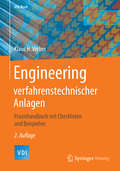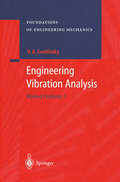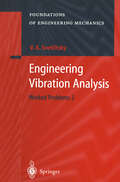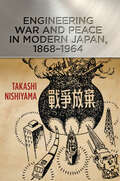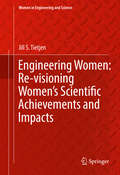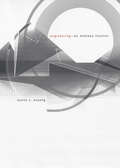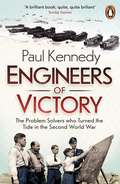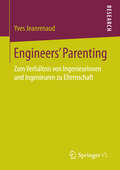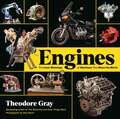- Table View
- List View
Engineering Tolerance in Crop Plants Against Abiotic Stress (Footprints of Climate Variability on Plant Diversity)
by Shah Fahad Osman Sönmez Shah Saud Depeng Wang Chao Wu Muhammad Adnan Muhammad Arif AmanullahDespite significant progress in increasing agricultural production, meeting the changing dietary preferences and increasing food demands of future populations remains a significant challenge. Salinity, drought, water logging, high temperature and toxicity are abiotic stresses that affect the crop yield and production. Tolerance for stress is a important characteristic that plants need to have in order to survive. Identification of proper techniques at a proper time can make it easy for scientists to increase crop productivity and yield. In Engineering Tolerance in Crop Plants against Abiotic Stress we have discussed the possible stresses and their impact on crops and portrayed distinctive abiotic stress tolerance in response to different techniques that can improve the performance of crops. Features of the Book: Provide a state-of-the-art description of the physiological, biochemical, and molecular status of the understanding of abiotic stress in plants. Address factors that threaten future food production and provide potential solution to these factors. Designed to cater to the needs of the students engaged in the field of environmental sciences, soil sciences, agricultural microbiology, plant pathology, and agronomy. New strategies for better crop productivity and yield. Understanding new techniques pointed out in this book will open the possibility of genetic engineering in crop plants with the concomitant improved stress tolerance.
Engineering Tools for Environmental Risk Management: 4. Risk Reduction Technologies and Case Studies (Engineering Tools for Environmental Risk Management)
by Katalin Gruiz Tamás Meggyes Éva FenyvesiThe four volumes of the book series "Engineering Tools for Environmental Risk Management" deal with environmental management, assessment & monitoring tools, environmental toxicology and risk reduction technologies. This last volume focuses on engineering solutions usually needed for industrial contaminated sites, where nature’s self-remediation is inefficient or too slow. The success of remediation depends on the selection of an increasing number of conventional and innovative methods. This volume classifies the remedial technologies and describes the reactor approach to understand and manage in situ technologies similarly to reactor-based technologies. Technology types include physicochemical, biological or ecological solutions, where near-natural, sustainable remediation has priority. A special chapter is devoted to natural attenuation, where natural changes can help achieve clean-up objectives. Natural attenuation and biological and ecological remediation establish a serial range of technologies from monitoring only to fully controlled interventions, using ‘ just’ the natural ecosystem or sophisticated artificial living systems. Passive artificial ecosystems and biodegradation-based remediation – in addition to natural attenuation – demonstrate the use of these ‘green’ technologies and how engineering intervention should be kept at a minimum to limit damage to the environment and create a harmonious ecosystem. Remediation of sites contaminated with organic substances is analyzed in detail including biological and physicochemical methods. Comprehensive management of pollution by inorganic contaminants from the mining industry, leaching and bioleaching and acid mine drainage is studied in general and specifically in the case of an abandoned mine in Hungary where the innovative technology of combined chemical and phytostabilization has been applied. The series of technologies is completed by electrochemical remediation and nanotechnologies. Monitoring, verification and sustainability analysis of remediation provide a comprehensive overview of the management aspect of environmental risk reduction by remediation. This book series focuses on the state of knowledge about the environment and its conscious and structured application in environmental engineering, management and decision making.
Engineering Tools for Environmental Risk Management: 3. Site Assessment and Monitoring Tools (Engineering Tools for Environmental Risk Management)
by Katalin Gruiz Tamas Meggyes Eva FenyvesiThis is the third volume of the five-volume book series “Engineering Tools for Environmental Risk Management”. The book series deals with the following topics: • Environmental deterioration and pollution, management of environmental problems• Environmental toxicology – a tool for managing chemical substances and contaminated environment• Assessment and monitoring tools, risk assessment• Risk reduction measures and technologies• Case studies for demonstration of the application of engineering tools The authors aim to describe interactions and options in risk management by providing a broad scientific overview of the environment, its human uses and the associated local, regional and global environmental problems; interpreting the holistic approach used in solving environmental protection issues; striking a balance between nature’s needs and engineering capabilities; understanding interactions between regulation, management and engineering; obtaining information about novel technologies and innovative engineering tools. This third volume provides an overview on the basic principles, concepts, practices and tools of environmental monitoring and contaminated site assessment. The volume focuses on those engineering tools that enable integrated site assessment and decision making and ensure an efficient control of the environment. Some topics supporting sustainable land use and efficient environmental management are listed below: • Efficient management and regulation of contaminated land and the environment;• Early warning and environmental monitoring;• Assessment of contaminated land: the best practices;• Environmental sampling;• Risk characterization and contaminated matrix assessment;• Integrated application of physical, chemical, biological, ecological and (eco) toxicological characterization methods;• Direct toxicity assessment (DTA) and decision making;• Online analyzers, electrodes and biosensors for assessment and monitoring of waters.;• In situ and real-time measurement tools for soil and contaminated sites;• Rapid on-site methods and contaminant and toxicity assessment kits;• Engineering tools from omics technologies, microsensors to heavy machinery;• Dynamic characterization of subsurface soil and groundwater using membrane interface probes, optical and X-ray fl uorescence and ELCAD wastewater characterization;• Geochemical modeling: methods and applications;• Environmental assessment using cyclodextrins. This book series focuses on the state of knowledge about the environment and its conscious and structured application in environmental engineering, management and decision making.
Engineering Tools for Environmental Risk Management: 2. Environmental Toxicology
by Katalin Gruiz Tamas Meggyes Eva FenyvesiChemical substances, physical agents and built structures exhibit various types of hazard due to their inherent toxic, mutagenic, carcinogenic, reprotoxic and sensitizing character or damaging to the immune and hormone system. The first steps in managing an environment contaminated by chemical substances are characterization of hazards and quantifi
Engineering Tools for Environmental Risk Management: 1. Environmental Deterioration and Contamination - Problems and their Management
by Katalin Gruiz Tamas Meggyes Eva FenyvesiThis is the first volume of the five-volume book seriesEngineering Tools for Environmental Risk Management dealing with the following topics: types and management of environmental deterioration, particularly pollution; environmental toxicology as a versatile tool in monitoring and risk management; risk assessment of chemical substances and c
Engineering Tools for Environmental Risk Management: 4. Risk Reduction Technologies and Case Studies (Engineering Tools for Environmental Risk Management #4)
by Katalin Gruiz Tamás Meggyes Éva FenyvesiThe four volumes of the book series "Engineering Tools for Environmental Risk Management" deal with environmental management, assessment & monitoring tools, environmental toxicology and risk reduction technologies. This last volume focuses on engineering solutions usually needed for industrial contaminated sites, where nature’s self-remediation is inefficient or too slow. The success of remediation depends on the selection of an increasing number of conventional and innovative methods. This volume classifies the remedial technologies and describes the reactor approach to understand and manage in situ technologies similarly to reactor-based technologies. Technology types include physicochemical, biological or ecological solutions, where near-natural, sustainable remediation has priority. A special chapter is devoted to natural attenuation, where natural changes can help achieve clean-up objectives. Natural attenuation and biological and ecological remediation establish a serial range of technologies from monitoring only to fully controlled interventions, using ‘ just’ the natural ecosystem or sophisticated artificial living systems. Passive artificial ecosystems and biodegradation-based remediation – in addition to natural attenuation – demonstrate the use of these ‘green’ technologies and how engineering intervention should be kept at a minimum to limit damage to the environment and create a harmonious ecosystem. Remediation of sites contaminated with organic substances is analyzed in detail including biological and physicochemical methods. Comprehensive management of pollution by inorganic contaminants from the mining industry, leaching and bioleaching and acid mine drainage is studied in general and specifically in the case of an abandoned mine in Hungary where the innovative technology of combined chemical and phytostabilization has been applied. The series of technologies is completed by electrochemical remediation and nanotechnologies. Monitoring, verification and sustainability analysis of remediation provide a comprehensive overview of the management aspect of environmental risk reduction by remediation. This book series focuses on the state of knowledge about the environment and its conscious and structured application in environmental engineering, management and decision making.
Engineering Tools for Environmental Risk Management: 3. Site Assessment and Monitoring Tools (Engineering Tools for Environmental Risk Management)
by Katalin Gruiz Tamás Éva FenyvesiThis is the third volume of the five-volume book series “Engineering Tools for Environmental Risk Management”. The book series deals with the following topics: • Environmental deterioration and pollution, management of environmental problems• Environmental toxicology – a tool for managing chemical substances and contaminated environment• Assessment and monitoring tools, risk assessment• Risk reduction measures and technologies• Case studies for demonstration of the application of engineering tools The authors aim to describe interactions and options in risk management by providing a broad scientific overview of the environment, its human uses and the associated local, regional and global environmental problems; interpreting the holistic approach used in solving environmental protection issues; striking a balance between nature’s needs and engineering capabilities; understanding interactions between regulation, management and engineering; obtaining information about novel technologies and innovative engineering tools. This third volume provides an overview on the basic principles, concepts, practices and tools of environmental monitoring and contaminated site assessment. The volume focuses on those engineering tools that enable integrated site assessment and decision making and ensure an efficient control of the environment. Some topics supporting sustainable land use and efficient environmental management are listed below: • Efficient management and regulation of contaminated land and the environment;• Early warning and environmental monitoring;• Assessment of contaminated land: the best practices;• Environmental sampling;• Risk characterization and contaminated matrix assessment;• Integrated application of physical, chemical, biological, ecological and (eco) toxicological characterization methods;• Direct toxicity assessment (DTA) and decision making;• Online analyzers, electrodes and biosensors for assessment and monitoring of waters.;• In situ and real-time measurement tools for soil and contaminated sites;• Rapid on-site methods and contaminant and toxicity assessment kits;• Engineering tools from omics technologies, microsensors to heavy machinery;• Dynamic characterization of subsurface soil and groundwater using membrane interface probes, optical and X-ray fl uorescence and ELCAD wastewater characterization;• Geochemical modeling: methods and applications;• Environmental assessment using cyclodextrins. This book series focuses on the state of knowledge about the environment and its conscious and structured application in environmental engineering, management and decision making.
Engineering Translational Models of Lung Homeostasis and Disease (Advances in Experimental Medicine and Biology #1413)
by Chelsea M. MaginCutting-edge engineering approaches towards modelling lung homeostasis and disease have created dynamic new opportunities for interdisciplinary collaboration and unprecedented progress toward understanding and treating lung disease. This text connects established research in lung biology and physiology to innovative engineering strategies for pulmonary modelling. This unique approach aims to encourage and facilitate progress among a greater audience of basic and translational scientists, clinicians, and medical practitioners. Engineering Translational Models of Lung Homeostasis and Disease illustrates the advances in lung tissue characterization, revealing dynamic changes in the structure, mechanics, and composition of the extracellular matrix. This information paves the way for tissue-informed engineering models of pulmonary tissue, improved design of clinical materials, and advances against a variety of common pathologies. Current translational challenges are highlighted, as are engineering opportunities to overcome these barriers. This foundational text holds valuable lessons for researchers and clinicians throughout the fields of engineering, materials science, cell biology, pulmonary medicine, and clinical science.· Each section focuses on a specific region of the lung, presenting either the biological or clinical perspective along with complimentary engineering approaches · Covers the interface of engineering and lung biology · Highlights emerging new models to study lung disease and repair
Engineering verfahrenstechnischer Anlagen: Praxishandbuch mit Checklisten und Beispielen (VDI-Buch)
by Klaus H. WeberDas Engineering beinhaltet die ganzheitliche technische Planung einer Anlage. Die gesamten Engineeringkosten machen bei Anlageninvestitionen ca. 15 bis 30 Prozent der Investitionskosten aus. Dabei liefert das Engineering die Basis, um die Investitionsentscheidung begründet herbeizuführen sowie die Anlage wirtschaftlich und zielgerecht zu errichten, in Betrieb zu nehmen und zu betreiben. Das Engineering beeinflusst somit erheblich die Gesamtkosten des Projektes und die Wirtschaftlichkeit des späteren Betriebs. Das Buch strukturiert den gesamten Engineeringprozess anhand eines Phasenmodells. Es ist eine praktische Handlungsanleitung für jeden, der Anlagenprojekte abwickelt und insbesondere am Engineering mitwirkt. Zahlreiche Checklisten, Templates und Praxisbeispiele weisen den Weg zur erfolgreichen Anlagenplanung sowie Zeit- und Kosteneinsparung.Das Buch ist in einer Reihe mit den bewährten Praxishandbüchern des Autors zur Inbetriebnahme bzw. Dokumentation verfahrenstechnischer Anlagen zu sehen.
Engineering verfahrenstechnischer Anlagen: Praxishandbuch mit Checklisten und Beispielen (VDI-Buch)
by Klaus H. WeberDie 2. Auflage dieses Buches ist eine vollständige Überarbeitung, Aktualisierung und wesentliche Erweiterung der vorherigen Auflage. Dies betrifft insbesondere die Darlegung und Beachtung neuer Rechtsvorschriften der EU und BRD sowie von aktuellen EU-Normen. Die Ausführungen zum Explosionsschutz, zur Risikobeurteilung und zur schutzrechtlichen Sicherung der Ergebnisse wurden wesentlich vertieft.Die Engineeringkosten machen bei Anlageninvestitionen ca. 15 bis 30 Prozent der Investitionssumme aus. Dabei liefert das Engineering die Basis, um die Investi-tionsentscheidung begründet herbeizuführen sowie die Anlage wirtschaftlich und zielgerecht zu errichten, in Betrieb zu nehmen und zu betreiben.Das Buch ist eine praktische Handlungsanleitung für jeden, der an der Abwicklung von Anlagenprojekten mitwirkt. Zahlreiche Checklisten, Templates und Beispiele weisen den Weg zum erfolgreichen Engineering (Anlagenplanung) und zur Kosteneinsparung. Insgesamt wurde der Seitenumfang deutlich erweitert und die Anzahl an Abbildungen, Tabellen, Beispielen und Checklisten um ca. 30 Prozent erhöht. Das Buch ist in einer Reihe mit den bewährten Praxishandbüchern des Autors zur Inbetriebnahme bzw. Dokumentation verfahrenstechnischer Anlagen zu sehen.
Engineering Vibration Analysis: Worked Problems 1 (Foundations of Engineering Mechanics)
by Valery A. SvetlitskyTheory of vibrations belongs to principal subjects needed for training mechani cal engineers in technological universities. Therefore, the basic goal of the mono graph "Advanced Theory of Vibrations 1" is to help students studying vibration theory for gaining experience in application of this theory for solving particular problems. Thus, while choosing the problems and methods to solve them, the close attention was paid to the applied content of vibration theory. The monograph is devoted to systems with a single degree of freedom and sys tems with a finite number of degrees of freedom. In particular, problems are for mulated associated with determination of frequencies and forms of vibrations, study of forced vibrations, analysis of both stable and unstable vibrations (includ ing those caused by periodic but anharmonic forces). The problems of nonlinear vibrations and of vibration stability, and those related to seeking probabilistic characteristics for solutions to these problems in the case of random forces are also considered. Problems related to parametric vibrations and statistical dynamics of mechanical systems, as well as to determination of critical parameters and of dy namic stability are also analyzed. As a rule, problems presented in the monograph are associated with particular mechanical systems and can be applied for current studies in vibration theory. Al lowing for interests of students independently studying theory of vibrations, the majority of problems are supplied with either detailed solutions or algorithms of the solutions.
Engineering Vibration Analysis: Worked Problems 2 (Foundations of Engineering Mechanics)
by Valery A. SvetlitskyConstantly increasing attention is paid in the course 'Vibration 'Theory' to vibration of mechanical systems with distributed parameters, since the real elements of machines, devices, and constructions are made of materials that are not perfectly rigid. 'Therefore, vibrations of the objects including, for ex ample, rod elastic elements excite the vibrations of these elements, which can produce a substantial effect on dynamic characteristics of moving objects and on readings of instruments. For a mechanical engineer working in the field of design of new technolo gies the principal thing is his know-how in developing the sophisticated math ematical models in which all specific features of operation of the objects under design in real conditions are meticulously taken into account. So, the main emphasis in this book is made on the methods of derivation of equations and on the algorithms of solving them (exactly or approximately) taking into con sideration all features of actual behavior of the forces acting upon elastic rod elements. 'The eigen value and eigen vector problems are considered at vibrations of curvilinear rods (including the rods with concentrated masses). Also consid ered are the problems with forced vibrations. When investigating into these problems an approximate method of numerical solution of the systems of lin ear differential equations in partial derivatives is described, which uses the principle of virtual displacements. Some problems are more complicated than others and can be used for practical works of students and their graduation theses.
Engineering Viscoelasticity
by Danton Gutierrez-LeminiEngineering Viscoelasticity covers all aspects of the thermo- mechanical response of viscoelastic substances that a practitioner in the field of viscoelasticity would need to design experiments, interpret test data, develop stress-strain models, perform stress analyses, design structural components, and carry out research work. The material in each chapter is developed from the elementary to the esoteric, providing the background in mathematics and mechanics that are central to understanding the subject matter being presented. This book also examines how viscoelastic materials respond to the application of loads, and provides practical guidelines to use them in the design of commercial, military and industrial applications.
Engineering War and Peace in Modern Japan, 1868–1964 (Johns Hopkins Studies in the History of Technology)
by Takashi NishiyamaNaval, aeronautic, and mechanical engineers played a powerful part in the military buildup of Japan in the early and mid-twentieth century. They belonged to a militaristic regime and embraced the importance of their role in it. Takashi Nishiyama examines the impact of war and peace on technological transformation during the twentieth century. He is the first to study the paradoxical and transformative power of Japan’s defeat in World War II through the lens of engineering.Nishiyama asks: How did authorities select and prepare young men to be engineers? How did Japan develop curricula adequate to the task (and from whom did the country borrow)? Under what conditions? What did the engineers think of the planes they built to support Kamikaze suicide missions? But his study ultimately concerns the remarkable transition these trained engineers made after total defeat in 1945. How could the engineers of war machines so quickly turn to peaceful construction projects such as designing the equipment necessary to manufacture consumer products? Most important, they developed new high-speed rail services, including the Shinkansen Bullet Train. What does this change tell us not only about Japan at war and then in peacetime but also about the malleability of engineering cultures?Nishiyama aims to counterbalance prevalent Eurocentric/Americentric views in the history of technology. Engineering War and Peace in Modern Japan, 1868–1964 sets the historical experience of one country’s technological transformation in a larger international framework by studying sources in six different languages: Chinese, English, French, German, Japanese, and Spanish. The result is a fascinating read for those interested in technology, East Asia, and international studies. Nishiyama's work offers lessons to policymakers interested in how a country can recover successfully after defeat.
Engineering War and Peace in Modern Japan, 1868–1964 (Johns Hopkins Studies in the History of Technology)
by Takashi NishiyamaNaval, aeronautic, and mechanical engineers played a powerful part in the military buildup of Japan in the early and mid-twentieth century. They belonged to a militaristic regime and embraced the importance of their role in it. Takashi Nishiyama examines the impact of war and peace on technological transformation during the twentieth century. He is the first to study the paradoxical and transformative power of Japan’s defeat in World War II through the lens of engineering.Nishiyama asks: How did authorities select and prepare young men to be engineers? How did Japan develop curricula adequate to the task (and from whom did the country borrow)? Under what conditions? What did the engineers think of the planes they built to support Kamikaze suicide missions? But his study ultimately concerns the remarkable transition these trained engineers made after total defeat in 1945. How could the engineers of war machines so quickly turn to peaceful construction projects such as designing the equipment necessary to manufacture consumer products? Most important, they developed new high-speed rail services, including the Shinkansen Bullet Train. What does this change tell us not only about Japan at war and then in peacetime but also about the malleability of engineering cultures?Nishiyama aims to counterbalance prevalent Eurocentric/Americentric views in the history of technology. Engineering War and Peace in Modern Japan, 1868–1964 sets the historical experience of one country’s technological transformation in a larger international framework by studying sources in six different languages: Chinese, English, French, German, Japanese, and Spanish. The result is a fascinating read for those interested in technology, East Asia, and international studies. Nishiyama's work offers lessons to policymakers interested in how a country can recover successfully after defeat.
Engineering Women: Re-visioning Women's Scientific Achievements And Impacts (Women in Engineering and Science)
by Jill S. TietjenPacked with fascinating biographical sketches of female engineers, this chronological history of engineering brightens previously shadowy corners of our increasingly engineered world’s recent past. In addition to a detailed description of the diverse arenas encompassed by the word ‘engineering’ and a nuanced overview of the development of the field, the book includes numerous statistics and thought provoking facts about women’s roles in the achievement of thrilling scientific innovations. This text is a unique resource for students launching research projects in engineering and related fields, professionals interested in gaining a broader understanding of how engineering as a discipline has been impacted by events of global significance, and scholars of women’s immense, often obscured, contributions to scientific progress.
Engineering—An Endless Frontier
by Sunny Y. AUYANGGenetic engineering, nanotechnology, astrophysics, particle physics: We live in an engineered world, one where the distinctions between science and engineering, technology and research, are fast disappearing. This book shows how, at the dawn of the twenty-first century, the goals of natural scientists--to discover what was not known--and that of engineers--to create what did not exist--are undergoing an unprecedented convergence. Sunny Y. Auyang ranges widely in demonstrating that engineering today is not only a collaborator with science but its equal. In concise accounts of the emergence of industrial laboratories and chemical and electrical engineering, and in whirlwind histories of the machine tools and automobile industries and the rise of nuclear energy and information technology, her book presents a broad picture of modern engineering: its history, structure, technological achievements, and social responsibilities; its relation to natural science, business administration, and public policies. Auyang uses case studies such as the development of the F-117A Nighthawk and Boeing 777 aircraft, as well as the experiences of engineer-scientists such as Oliver Heaviside, engineer-entrepreneurs such as Henry Ford and Bill Gates, and engineer-managers such as Alfred Sloan and Jack Welch to give readers a clear sense of engineering's essential role in the future of scientific research. Table of Contents: Preface 1. Introduction 2 . Technology Takes Off 2.1 From Practical Art to Technology 2.2 Construction Becomes Mathematical 2.3 Experimenting with Machines 2.4 Science and Chemical Industries 2.5 Power and Communication 3. Engineering for Information 3.1 From Microelectronics to Nanotechnology 3.2 Computer Hardware and Software 3.3 Wireless, Satellites, and the Internet 4. Engineering in Society 4.1 Social Ascent and Images of Engineers 4.2 Partnership in Research and Development 4.3 Contributions to Sectors of the Economy 5. Innovation by Design 5.1 Inventive Thinking in Negative Feedback 5.2 Design Processes in Systems Engineering 5.3 “Working Together� in Aircraft Development 5.4 From Onboard Computers to Door Hinges 6. Sciences of Useful Systems 6.1 Mathematics in Engineering and Science 6.2 Information and Control Theories 6.3 Wind Tunnels and Internet Simulation 6.4 Integrative Materials Engineering 6.5 Biological Engineering Frontiers 7. Leaders Who Are Engineers 7.1 Business Leaders in the Car Industry 7.2 Public Policies and Nuclear Power 7.3 Managing Technological Risks Appendix A. Statistical Profiles of Engineers Appendix B. U.S. Research and Development Notes Index I am impressed by the scope of Engineering - An Endless Frontier, and fascinated by Sunny Auyang's comprehensive knowledge of the subject. This is just the kind of book the National Academy of Engineering has been encouraging to promote the importance of engineering to the public. It will have a long shelf-life in that it pulls together material that is not readily accessible, and will serve as a reference for anyone interested in engineering as a profession. Engineering needs this book!--John Hutchinson, Harvard UniversityEngineering - An Endless Frontier is extraordinary in scope. Sunny Auyang describes the different kinds of contemporary engineering practices and productions, attempts to provide historical background, explains the scientific basis for engineering innovation in different fields, and addresses the broad, systems level managerial, entrepreneurial, and design activities of professionals. It's rare to find a single author who can grasp and explain the essential features of modern technologies across such an array of industrial sectors and engineering disciplines and explain how they work, why they work they way they do,
Engineers of Victory: The Problem Solvers who Turned the Tide in the Second World War
by Paul KennedyFrom Paul Kennedy, author of The Rise and Fall of the Great Powers, one of the most acclaimed history books of recent decades, Engineers of Victory is a new account of how the tide was turned against the Nazis by the Allies in the Second World War. In January 1943 Churchill and Roosevelt and the Combined Chiefs of Staff met in Casablanca to review the western Allies' war aims and strategy. They realised that to attain their ultimate aim of 'unconditional surrender' they would have to achieve some formidable objectives - win control of the Atlantic sea-lanes and command of the air over the whole of West-Central Europe, work out how to land on an enemy-held shore so that Continental Europe could be retaken, how to blunt the Nazi blitzkrieg that a successful invasion would undoubtedly provoke, and finally how to 'hop' across the islands of the Pacific to assault the Japanese mainland. Eighteen months later on, as Paul Kennedy writes, 'these operational aims were either accomplished or close to being so.' The history of the Second World War is often told as a grand narrative. The focus of this book, by contrast, is on the problem-solvers - Major-General Perry Hobart, who invented the 'funny tanks' which flattened the curve on the D-Day beaches; Flight Lieutenant Ronnie Harker 'the man who put the Merlin in the Mustang'; Captain 'Johnny' Walker, the convoy captain who worked out how to sink U-boats with a 'creeping barrage'. The result is a fresh perspective on the greatest, conflict in human history.Paul Kennedy is one of the world's best-selling and most influential historians. He is the author or editor of nineteen books, including The Rise and Fall of the Great Powers, which has been translated into over twenty languages, Preparing for the Twenty-First Century, The Parliament of Man and the now classic Rise and Fall of British Naval Mastery.
Engineers’ Parenting: Zum Verhältnis von Ingenieurinnen und Ingenieuren zu Elternschaft
by Yves JeanrenaudYves Jeanrenaud zeichnet die Konstruktion von Elternschaft hinsichtlich spezifischer Berufskultur und Fachhabitus der Ingenieurwissenschaften anhand narrativer Interviews mit Ingenieurinnen und Ingenieuren nach. Der Ingenieurberuf gilt gemeinhin als traditionell, besonders in Bezug auf die Zuschreibung von Geschlechterrollen zu Karriere, Familie und Elternschaft. Diese traditionelle, bürgerliche Berufskultur hat entsprechende Auswirkungen auf die Vorstellungen davon, was Familie ausmacht und wie Elternrollen auszufüllen sind. Diese Studie zeigt, wie doing engineering das Familien- und Elternschafts-Modell von Ingenieurinnen und Ingenieuren strukturiert. Dabei erweist sich die Berufs- und Studienwahl als Schlüssel zur professionellen Identitätskonstruktion. Auf Basis dieser Entscheidungsprozesse wird Elternschaft vor dem Hintergrund der Erwerbsbiografie konstruiert und damit die Trennung des Erwerbs- und Familienlebens in privat und öffentlich aufgrund des Fachhabitus aufrechterhalten und die bürgerliche Geschlechterordnung perpetuiert.
Engines: The Inner Workings of Machines That Move the World
by Theodore GrayThe international bestselling author of How Things Work and The Elements Trilogy turns his focus to a visual exploration of the inner workings and functionality of the marvelous machines that run our world—from the first steam engines to giant turbines to today's tiny electrical engines. In Engines, the always entertaining and informative Theodore Gray explores the glorious guts and intricate innards of dozens of impressive machines. Through his engaging and unexpected stories and Nick Mann&’s trademark gorgeous photography, Gray takes us on a journey from ancient Greek steam engines to our most sophisticated twenty-first-century machinery. We take time to appreciate the detailed functionality of the internal combustion engine, the connection between magnetism and electric motors, as well as hydraulics, robotics, and more. Each chapter builds on the previous, illuminating the evolution of engines and revealing the ingenuity brought to bear as humans invented and perfected these marvelous mechanical systems. Along the way, Gray regales us with tales of his own experiences working with and collecting these machines. For fans of how things are made and how they work, Engines is a loving tribute to the mechanical world.
Engines: The Inner Workings of Machines That Move the World
by Theodore GrayThe international bestselling author of How Things Work and The Elements Trilogy turns his focus to a visual exploration of the inner workings and functionality of the marvelous machines that run our world—from the first steam engines to giant turbines to today's tiny electrical engines. In Engines, the always entertaining and informative Theodore Gray explores the glorious guts and intricate innards of dozens of impressive machines. Through his engaging and unexpected stories and Nick Mann&’s trademark gorgeous photography, Gray takes us on a journey from ancient Greek steam engines to our most sophisticated twenty-first-century machinery. We take time to appreciate the detailed functionality of the internal combustion engine, the connection between magnetism and electric motors, as well as hydraulics, robotics, and more. Each chapter builds on the previous, illuminating the evolution of engines and revealing the ingenuity brought to bear as humans invented and perfected these marvelous mechanical systems. Along the way, Gray regales us with tales of his own experiences working with and collecting these machines. For fans of how things are made and how they work, Engines is a loving tribute to the mechanical world.
Engines and Fuels for Future Transport (Energy, Environment, and Sustainability)
by Avinash Kumar Agarwal Gautam Kalghatgi Felix Leach Kelly SenecalThis book focuses on clean transport and mobility essential to the modern world. It discusses internal combustion engines (ICEs) and alternatives like battery electric vehicles (BEVs) which are growing fast. Alternatives to ICEs start from a very low base and face formidable environmental, material availability, and economic challenges to unlimited and rapid growth. Hence ICEs will continue to be the main power source for transport for decades to come and have to be continuously improved to improve transport sustainability. The book highlights the need to assess proposed changes in the existing transport system on a life cycle basis. The volume includes chapters discussing the challenges faced by ICEs as well as chapters on novel fuels and fuel/ engine interactions which help in this quest to improve the efficiency of ICE and reduce exhaust pollutants. This book will be of interest to those in academia and industry alike.
England and the French Revolution (Context and Commentary)
by Stephen Prickett...few titles are likely to be more useful to undergraduates...a fine introduction to a complex and inexhaustibly fascinating subject.' Choice Magazine
Englisch-Deutsches und Deutsch-Englisches Taschenwörterbuch
by Ignaz Emanuel WesselyDieser Buchtitel ist Teil des Digitalisierungsprojekts Springer Book Archives mit Publikationen, die seit den Anfängen des Verlags von 1842 erschienen sind. Der Verlag stellt mit diesem Archiv Quellen für die historische wie auch die disziplingeschichtliche Forschung zur Verfügung, die jeweils im historischen Kontext betrachtet werden müssen. Dieser Titel erschien in der Zeit vor 1945 und wird daher in seiner zeittypischen politisch-ideologischen Ausrichtung vom Verlag nicht beworben.







